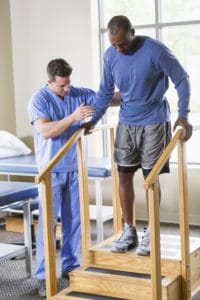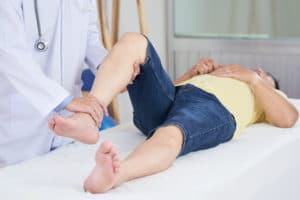An orthopedic injury and subsequent surgical treatment can result in limited physical movement. Where there are limitations in body mechanics, even temporarily, there is a loss of freedom. Orthopedic rehabilitation is the process through which patients receive the expert care they need to rebuild an optimal quality of life. Here at Summit Health Care, we take pride in helping our patients regain strength to get back their everyday routine.
Goals of Rehabilitation
The goals of orthopedic rehabilitation may vary based on the timeline of recovery. Initially, inpatient care may involve a multi-disciplinary approach to reinstate normal physical function and the performance of daily activities. Objectives also include a safe and pain-free return to work, hobbies, or sports. Through appropriate therapies, a rehabilitation program sets the foundation for independent living as well as active support among family members when needed.
Outpatient orthopedic rehabilitation may center around the improvement of physical function, also beginning with daily activities and progressing to work and other physical pursuits.
When necessary, rehabilitation revolves around the development of healthy pain management strategies, lifestyle habits, and learning to use adaptive equipment such as a prosthetic or brace.
What Our Patients at Summit Have to Say
“Our Family is truly thankful for the quality care Summit healthcare provides us with. ” – Kristie
Benefits of Orthopedic Rehabilitation
Patients who engage in a custom orthopedic rehabilitation plan receive benefits such as:
- Restored range of motion and physical function in an injured joint
- Muscle strength around an injured joint to reduce the risk of future injury
- Improved circulation after surgery to support healing and minimize the risk of blood clots
- Faster return to normal activities

What To Expect During Rehabilitation
An orthopedic rehabilitation program may take place in our hospital or on an outpatient basis. Details are decided by the patient and doctor based on the severity of the injury, type of surgery, and other factors. Minor injuries and procedures such as the repair of the ACL in the knee may be rehabilitated with physical therapy in an outpatient setting. Severe breaks or significant procedures such as knee or hip replacement may require a short inpatient stay.
Inpatient care may involve multiple medical teams, including the surgeon, nursing staff, and physical and occupational therapists. Teams work independently but toward the same goal of achieving significant gains in physical function within a reasonable time frame. Patients can expect to engage in at least a few hours of therapy each day, up to six days a week. Family members may also be involved in rehabilitation in order to understand the physical needs and limitations to expect after discharge.
Rehabilitation: Physical & Occupational Therapy
This rehabilitation process may focus on movements such as
- getting in and out of bed safely
- moving from a seated to a standing position
- walking up and down stairs
Occupational therapy may involve daily tasks such
- as getting dressed
- bathing
- eating
- moving around in your room
What is orthopedic rehabilitation?
Orthopedic rehabilitation is a personalized post-treatment program that focuses on the specific improvements a patient needs to achieve. For example, physical therapy services during orthopedic rehabilitation can expedite healing after surgery and restore an adequate range of motion to an injured joint.
Why do I need post-op orthopedic rehab?
Studies have suggested that post-operative orthopedic rehabilitation aids in a patient’s recovery process. Our trained healthcare providers will give you a personalized program that addresses the issue of pain management and facilitates a return to work, athletics, and an overall active lifestyle that is free of chronic pain. The staff at Summit Healthcare Orthopedic Center seeks to empower patients to heal as quickly as possible and regain optimal physical capabilities that support their desired lifestyle.
What activities are involved in rehabilitation?
Orthopedic rehabilitation may look different for every patient. Some of the common aspects of care include:
- Interdisciplinary therapies for pain management
- Physical therapy focused on functional movement & improved strength
- Occupational therapy focused on the performance of daily activities
- The learned use of orthotics, braces, or other equipment
- Patient education regarding injury prevention and risk factors
- Assistance with functional living space that supports a safe discharge
- Adaptive recreational or sports programs
Every rehabilitation plan is unique and based on the short and long-term needs of the patient.
What Conditions Does Physical Therapy Treat?
Physical therapy may be ordered for a number of different situations. Here, our focus is to restore optimal range of motion, comfort, and function after treatment for an orthopedic injury. Common orthopedic injuries include tears to muscles or tendons in the knee, shoulder, hip, or other joint.
Does Every Orthopedic Surgery Require Post-Surgery Rehab?
It is very common for post-surgery rehabilitation to occur. Injury to a joint, bone, or even soft tissue can alter your posture or the way you move. Surgery repairs the injury but your range of motion and functional movement may not automatically resume. To prevent further injury or unnecessary stress on the repaired area, your doctor may order a certain number of physical therapy sessions to occur over the span of up to several weeks.
Can Orthopedic Rehabilitation Reduce My Need for Surgery?
The effectiveness of orthopedic rehabilitation to prevent the need for surgery may depend on several factors. First, the type of injury that has occurred and its severity. Some injuries can only be repaired surgically, after which rehabilitation can enhance the surgical outcome. Minor injuries such as sprains, strains, and very mild tears, may improve nicely with physical therapy alone. Your doctor and physical therapy team may meet periodically to discuss your case and your progression in terms of comfort level and physical movement to determine the necessity for surgery.
How Can a Home Care Professional Help with Orthopedic Rehab?
If it is difficult or impossible for you to leave home after an injury or surgery to receive physical therapy, a therapist can come to your home to work with you. In-home physical therapy sessions may only be necessary for a short time until you are well enough to attend sessions at a facility. At home, your therapist can perform exercises and stretches that will progress your healing process. They can also demonstrate and teach you how to properly perform exercises on your own. Your in-home sessions may not involve ancillary modalities that are often used in a facility, such as ultrasound, but they can still be very effective.
Do I Really have to Do Home Exercises?
When you've done the work requested of you during your formal physical therapy sessions, the idea of homework may sound unnecessary. It's not. Multiple studies have proven that doing the recommended exercises in between your physical therapy sessions can make an enormous difference in your recovery from pain, your overall recovery time, and much more. Sustaining your recommended schedule for physical therapy homework, you may accelerate the restoration of balance, flexibility, and strength. The work that you complete at home in between sessions augments what has already begun so you can progress to new exercises in fewer sessions. Doing your physical therapy homework will not reduce the number of sessions you'll need to complete, but it can significantly enhance what you achieve through your course of rehabilitation. Additionally, the improvements that are achieved between formal sessions and homework can dramatically reduce your risk of future injury to the affected joint or body part.
Some of the Rehab Exercises Make me Sore, should I Keep Doing Them?
Unless your physical therapist has said that they do not want you to experience any pain whatsoever when performing exercises, a little soreness is acceptable. It is not unusual for soreness and inflammation to occur in the 24 to 48 hours after performing recommended exercises. Your therapist can talk with you about the degree of soreness that you might tolerate and what other symptoms may require you to stop. Feeling pain during certain movements, for example, may be an indication that you're not yet ready to perform that exercise on your own or that your therapist needs to show you how to perform the movement without too much strain on the injured area.
How long does rehab treatment last?
Orthopedic rehabilitation may last a few days or several months depending on the extent of physical function that needs to be regained. Inpatient programs are often planned in anticipation of discharge within approximately 10 days. Inpatient rehabilitation may be followed by outpatient care as needed to fully restore mobility and comfortable living.
Schedule A Consultation
Contact us to learn more about the orthopedic rehabilitation services available at Summit Healthcare Orthopedic Center. Our practice serves Snowflake, Show Low, and surrounding areas in Arizona.



